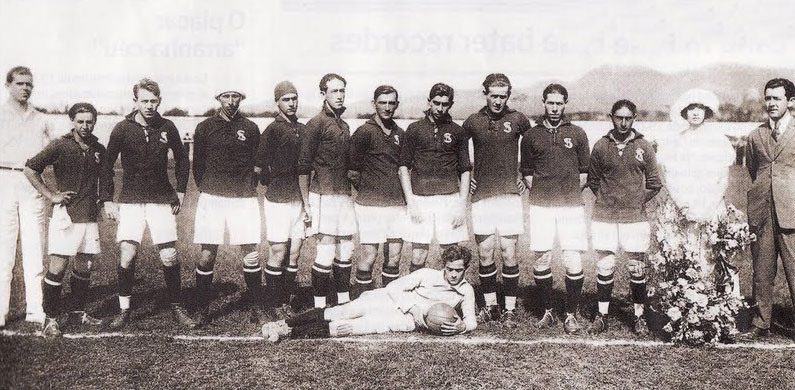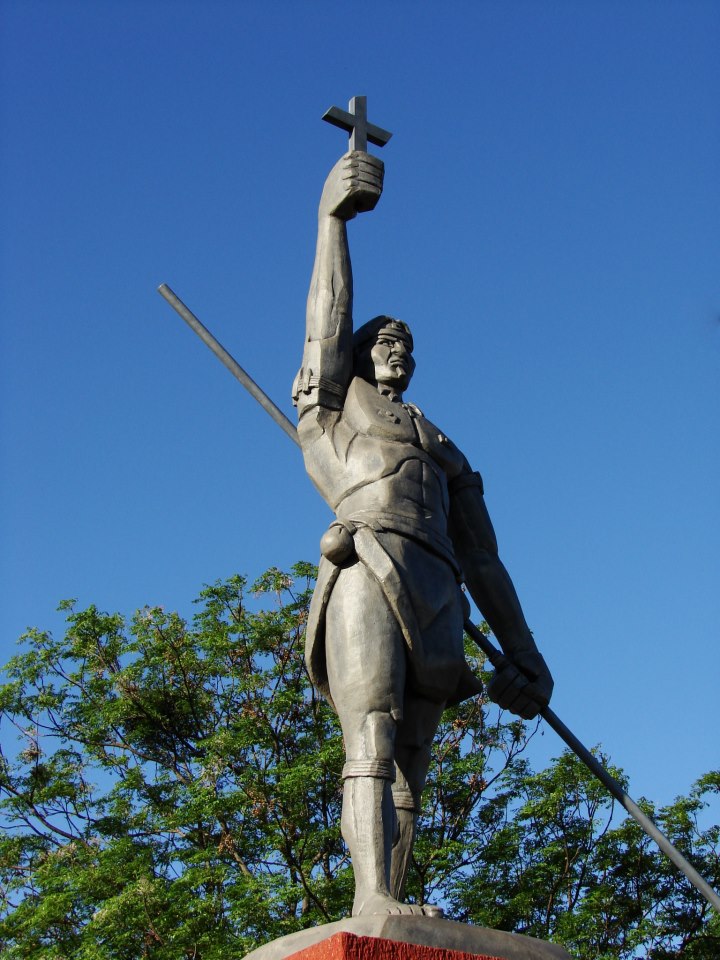|
Pedro Leopoldo
Pedro Leopoldo is a Brazilian municipality in the state of Minas Gerais. The city is located in the Greater Belo Horizonte region. As of 2020, the estimated population was 94,712. The city is birthplace to prominent medium Chico Xavier and 1970 World Champion and Cruzeiro footballer Dirceu Lopes. The municipality contains 44% of the Sumidouro State Park, created in 1980. The Casa Fernão Dias is in the Quinta do Sumidouro district of Pedro Leopoldo. It is listed by the State Institute of Historic and Artistic Heritage (IEPHA) as a cultural heritage monument. It contain exhibits that tell the history of Fernão Dias, a bandeirante who spent several years in the region with his followers in search of gold and precious stones. The house contains an annex where the state park's administrative staff work. See also * List of municipalities in Minas Gerais This is a list of the municipalities in the state of Minas Gerais (MG), located in the Southeast Region of Brazil. Minas Ge ... [...More Info...] [...Related Items...] OR: [Wikipedia] [Google] [Baidu] |
Minas Gerais
Minas Gerais () is a state in Southeastern Brazil. It ranks as the second most populous, the third by gross domestic product (GDP), and the fourth largest by area in the country. The state's capital and largest city, Belo Horizonte (literally "Beautiful Horizon"), is a major urban and finance center in Latin America, and the sixth largest municipality in Brazil, after the cities of São Paulo, Rio de Janeiro, Salvador, Brasília and Fortaleza, but its metropolitan area is the third largest in Brazil with just over 5.8 million inhabitants, after those of São Paulo and Rio de Janeiro. Nine Brazilian presidents were born in Minas Gerais, the most of any state. The state has 10.1% of the Brazilian population and is responsible for 8.7% of the Brazilian GDP. With an area of —larger than Metropolitan France—it is the fourth most extensive state in Brazil. The main producer of coffee and milk in the country, Minas Gerais is known for its heritage of architecture and colonia ... [...More Info...] [...Related Items...] OR: [Wikipedia] [Google] [Baidu] |
Greater Belo Horizonte
Greater Belo Horizonte, Brazil, is the name usually used to describe the Belo Horizonte metropolitan region, which is composed of 34 municipalities. As of 2013, it is the third largest metropolitan area of Brazil with more than Six million inhabitants; the largest city by population is Belo Horizonte. Cities In total, 34 municipalities are part of the Belo Horizonte Metropolitan area: Baldim, Belo Horizonte, Betim, Brumadinho, Caeté, Capim Branco, Confins, Contagem, Esmeraldas, Florestal, Ibirité, Igarapé, Itaguara, Itatiaiuçu, Jaboticatubas, Nova União, Juatuba, Lagoa Santa, Mário Campos, Mateus Leme, Matozinhos, Nova Lima, Pedro Leopoldo, Raposos, Ribeirão das Neves, Rio Acima, Rio Manso, Sabará, Santa Luzia, São Joaquim de Bicas, São José da Lapa, Sarzedo, Taquaraçu de Minas, Vespasiano. Metropolitan Belt The metropolitan belt ( pt, Colar Metropolitano) of the Belo Horizonte metropolitan area is composed of 16 municipalities: Barão de Cocais, ... [...More Info...] [...Related Items...] OR: [Wikipedia] [Google] [Baidu] |
Mediumship
Mediumship is the practice of purportedly mediating communication between familiar spirits or ghost, spirits of the dead and living human beings. Practitioners are known as "mediums" or "spirit mediums". There are different types of mediumship or spirit conduit (channeling), channelling, including table-turning, séance tables, trance, and ouija. Belief in psychic ability is widespread despite the absence of objective evidence for its existence. Scientific researchers have attempted to ascertain the validity of claims of mediumship. An experiment undertaken by the British Psychological Society led to the conclusion that the test subjects demonstrated no mediumistic ability. Mediumship gained popularity during the nineteenth century, when ouija boards were used as a source of entertainment. Investigations during this period revealed widespread fraud—with some practitioners employing techniques used by Magic (illusion), stage magicians—and the practice began to lose credibilit ... [...More Info...] [...Related Items...] OR: [Wikipedia] [Google] [Baidu] |
Chico Xavier
Chico Xavier () or Francisco Cândido Xavier, born Francisco de Paula Cândido (, April 2, 1910 – June 30, 2002), was a popular Brazilian philanthropist and spiritist medium. During a period of 60 years he wrote over 490 books and several thousand letters claiming to use a process known as "psychography". Books based on old letters and manuscripts were published posthumously, bringing the total number of books to 496. Playfair, Guy Lyon. ''Chico Xavier, Medium of the Century''. Roundtable Publishing, 2010, The books written by Chico covered a vast range of topics from religion, philosophy, historical romances and novels, Portuguese Literature, poetry, and science, as well as thousands of letters intended to inform, console and uplift the families of deceased persons during his psychographic sessions. His books sold an estimated 50 million copies and the revenue generated by it was totally channeled into charity work.Langellier JP''Un homme insignifiant''. Le Monde, 12/05/ ... [...More Info...] [...Related Items...] OR: [Wikipedia] [Google] [Baidu] |
1970 FIFA World Cup
The 1970 FIFA World Cup was the ninth edition of the FIFA World Cup, the quadrennial international Association football, football championship for List of men's national association football teams, men's senior national teams. Held from 31 May to 21 June in Mexico, it was the first World Cup tournament held outside Europe and South America, and it was also the first held in North America. Teams representing 75 nations from all six populated continents entered the competition, and its 1970 FIFA World Cup qualification, qualification rounds began in May 1968. Fourteen teams qualified from this process to join host nation Mexico national football team, Mexico and defending champions England national football team, England in the 16-team final tournament. El Salvador national football team, El Salvador, Israel national football team, Israel and Morocco national football team, Morocco made their debut appearances at the final stage. The 1970 FIFA World Cup Final, tournament final had ... [...More Info...] [...Related Items...] OR: [Wikipedia] [Google] [Baidu] |
Cruzeiro Esporte Clube
Cruzeiro Esporte Clube (), known simply as Cruzeiro, is a Brazilian sports club based in Belo Horizonte, Minas Gerais. Although they compete in a number of different sports, Cruzeiro is mostly known for its association football team. It plays in the Campeonato Brasileiro Série A, the top tier of the Brazilian football league system, as well as in the Campeonato Mineiro, the States of Brazil, state of Minas Gerais's premier State football leagues in Brazil, state league. The club was founded on 2 January 1921, by sportsmen from the Italian colony of Belo Horizonte as ''Palestra Itália''. As a result of the Second World War, the Federal government of Brazil, Brazilian federal government banned the use of any symbols referring to the Axis powers in 1942. The club board members rebaptized the club with the name of a leading national symbol: the Crux, Cruzeiro do Sul's constellation. Cruzeiro play their home games at the Mineirão stadium, which currently holds up to 62,547 spect ... [...More Info...] [...Related Items...] OR: [Wikipedia] [Google] [Baidu] |
Association Football
Association football, more commonly known as football or soccer, is a team sport played between two teams of 11 players who primarily use their feet to propel the ball around a rectangular field called a pitch. The objective of the game is to score more goals than the opposition by moving the ball beyond the goal line into a rectangular framed goal defended by the opposing side. Traditionally, the game has been played over two 45 minute halves, for a total match time of 90 minutes. With an estimated 250 million players active in over 200 countries, it is considered the world's most popular sport. The game of association football is played in accordance with the Laws of the Game, a set of rules that has been in effect since 1863 with the International Football Association Board (IFAB) maintaining them since 1886. The game is played with a football that is in circumference. The two teams compete to get the ball into the other team's goal (between the posts and under t ... [...More Info...] [...Related Items...] OR: [Wikipedia] [Google] [Baidu] |
Dirceu Lopes
Dirceu Lopes, full name Dirceu Lopes Mendes (born 3 September 1946 in Pedro Leopoldo Pedro Leopoldo is a Brazilian municipality in the state of Minas Gerais. The city is located in the Greater Belo Horizonte region. As of 2020, the estimated population was 94,712. The city is birthplace to prominent medium Chico Xavier and 19 ...) is a retired Brazilian footballer. He was attacking midfielder and forward who played mainly with Cruzeiro. He had seven caps with the Brazil national team, scoring one goal. References 1946 births Living people Brazilian footballers Brazil international footballers 1975 Copa América players Cruzeiro Esporte Clube players Fluminense FC players People from Pedro Leopoldo Association football midfielders Association football forwards Sportspeople from Minas Gerais {{brazil-footy-forward-1940s-stub ... [...More Info...] [...Related Items...] OR: [Wikipedia] [Google] [Baidu] |
Sumidouro State Park
The Sumidouro State Park ( pt, Parque Estadual do Sumidouro) is a state park in the state of Minas Gerais, Brazil. The remains of the first human inhabitants of Brazil were found in the park area in the early 19th century, along with bones of now-extinct megafauna. The main attraction is the Gruta da Lapinha, a large limestone cave. Location The Sumidouro State Park is in the municipalities of Lagoa Santa (56%) and Pedro Leopoldo (44%) to the north of the metropolitan area of Belo Horizonte, Minas Gerais. It is from Belo Horizonte. The park is in the federal Carste de Lagoa Santa Environmental Protection Area. It has an area of . The unit was named after its lagoon, ''Sumidouro'' ("sink"). The lagoon is drained by a network of galleries through which the water penetrates underground into the limestone basin. History The Danish naturalist Peter Wilhelm Lund conducted research in the area now covered by the park in the first half of the 19th century. He found remains of Lago ... [...More Info...] [...Related Items...] OR: [Wikipedia] [Google] [Baidu] |
Fernão Dias
Fernão Dias Pais Leme (1608–1681) or was a frontiersman from São Paulo. He was known as the "Emerald Hunter" and was one of the most prominent bandeirantes together with Antônio Raposo Tavares. He is the great-great-grandfather of the Saint Frei Galvão. The Casa Fernão Dias, run by the Sumidouro State Park, is in the Quinta do Sumidouro district of Pedro Leopoldo Pedro Leopoldo is a Brazilian municipality in the state of Minas Gerais. The city is located in the Greater Belo Horizonte region. As of 2020, the estimated population was 94,712. The city is birthplace to prominent medium Chico Xavier and 19 ..., Minas Gerais. It is listed by the State Institute of Historic and Artistic Heritage (IEPHA) as a cultural heritage monument. The exhibits tell the history of Fernão Dias, who spent several years in the region with his followers in search of gold and precious stones. References Sources * 1608 births 1681 deaths Portuguese explorers of South America ... [...More Info...] [...Related Items...] OR: [Wikipedia] [Google] [Baidu] |
Bandeirantes
The ''Bandeirantes'' (), literally "flag-carriers", were slavers, explorers, adventurers, and fortune hunters in early Colonial Brazil. They are largely responsible for Brazil's great expansion westward, far beyond the Tordesillas Line of 1494, by which Pope Alexander VI divided the new continent into a western, Crown of Castile, Castilian section, and an eastern, Portugal, Portuguese section. The ''bandeirantes'' were also known as Paulistas and Mamelucos. They mostly hailed from the São Paulo (state), São Paulo region, called the Captaincy of São Vicente until 1709 and then as the Captaincy of São Paulo. The São Paulo settlement served as the home base for the most famous ''bandeirantes.'' Some ''bandeirante'' leaders were descendants of first- and second-generation Portuguese who settled in São Paulo, but the bulk of their numbers was made of people of mameluco background (people of both European and Indigenous peoples in Brazil, Indian ancestries) and natives. Misceg ... [...More Info...] [...Related Items...] OR: [Wikipedia] [Google] [Baidu] |






